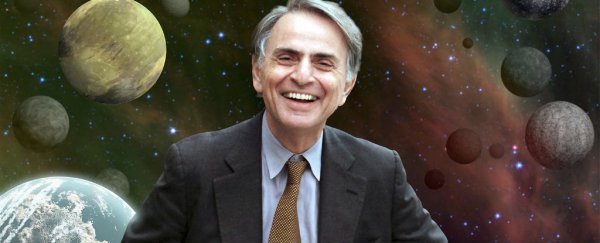Back in 1995, everyone's favourite astrophysicist, Carl Sagan, published a book called The Demon-Haunted World, which warned against the dangers of pseudoscience and scientific illiteracy, and encouraged its readers to learn critical and skeptical thinking.
Pretty standard stuff for a socially conscious scientist, but one passage in particular has been blowing up on Twitter this week, and it's not hard to see why.
Somehow, (we're not saying time machine, but probably time machine) Sagan managed to predict the state of things as they are today - and it's unnervingly accurate.
We're talking the decline in manufacturing jobs; people feeling hopeless about politics; politicians refusing or unable to represent the public interest; and brilliant, revolutionary technologies that never seem to change the lives of anyone but the 1 percent.
The result? Sagan predicts people will opt for superstition and pseudoscience over reality - and even more concerning, he says the public will be intellectually incapable of distinguishing between what makes us feel good, and what's actually true. Fake news, anyone?
Yep, this passage has got it all:
Suspecting Carl Sagan had either a time machine or a crystal ball.
— Charles Bergquist (@cbquist) January 23, 2017
Ok, probably the time machine. pic.twitter.com/zpKH1HUYhz
So did Sagan somehow know enough about society in 1995 that he could accurately predict what life would be like in a couple of generations, or are we all reading too much into it?
Oddly enough, the way we interpret this kind of prediction actually has a lot to do with how we interpret horoscopes - one of Sagan's biggest bugbears.
Horoscopes have nothing to do with reality, but they owe their enormous success to the fact that humans tend to see what they want to see.
So while we can be pessimistic about the future of society as a whole, humans are generally pretty optimistic about their individual future prospects - a concept known as optimism bias.
It's actually an evolutionary survival tactic - and that's something horoscopes directly tap into.
As Tali Sharot, a cognitive neuroscientist from University College London, explains for TIME:
"You might expect optimism to erode under the tide of news about violent conflicts, high unemployment, tornadoes and floods and all the threats and failures that shape human life. Collectively we can grow pessimistic - about the direction of our country or the ability of our leaders to improve education and reduce crime. But private optimism, about our personal future, remains incredibly resilient."
Thanks to humanity's optimism bias, you could show someone all the statistics related to divorce, cancer, and average lifespan, and more often than not, they'll choose to believe that those negative experiences won't happen to them.
So when we see horoscopes that tell us we're going to meet our soulmate or get a big promotion this month, we choose to believe it, and don't tend to go back and fact-check it - the horoscope has already done its job by making us feel good.
A similar thing goes on when we're presented with a spookily accurate prediction of the future - part of the cognitive bias that's wired into all humans is that we are drawn to details that confirm our existing beliefs.
As Matt Novak points out over at Gizmodo: "[I]t's important to remember that the 'accuracy' of predictions is often a Rorschach test. An interpretation of a particular prediction's accuracy usually says a lot about the people interpreting them, and their own hopes or fears for the future."
We also need to put these predictions into context, because once you read past the viral passage, you'll see that Sagan is kinda trying to blame the state of things in the future on… Beavis and Butthead?
"The dumbing down of America is most evident in the slow decay of substantive content in the enormously influential media, the 30-second sound bites (now down to 10 seconds or less), lowest common denominator programming, credulous presentations on pseudoscience and superstition, but especially a kind of celebration of ignorance.
As I write, the number one video cassette rental in America is the movie Dumb and Dumber. Beavis and Butthead remains popular (and influential) with young TV viewers. The plain lesson is that study and learning - not just of science, but of anything - are avoidable, even undesirable."
How delighted Sagan would be to know that in 2016, more young people were watching David Attenborough than The X Factor. Mind-numbing television is actually the least of our problems right now.
But even with all that said, we do have to give props to Sagan for coming up with a really cracking prediction for the beginning of 2017. Let's hope for better things to come in the months and years ahead.
